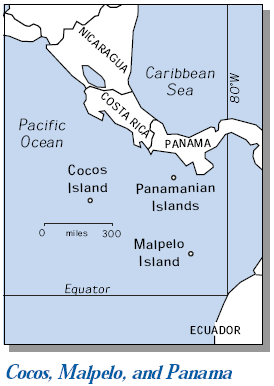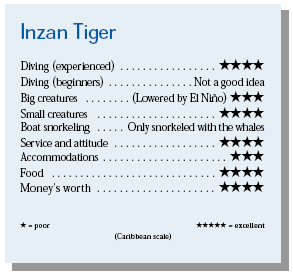Diving Cocos, Malpelo, and PanamaContents of this Issue: Diving Cocos, Malpelo, and Panama Welcome to the Caribbean Sea Lice Season Editorial Office: Ben Davison Publisher and Editor Undercurrent 3020 Bridgeway, Suite 102 Sausalito, CA 94965 An adventure aboard the Inzan Tiger from the May, 1998 issue of Undercurrent
Our three days of diving off Panama’s west coast had been filled with fantastic underwater adventures. This area is certainly one of the best new areas to be discoved by the diving world, a fine way to conclude my trip aboard The Inzan Tiger, a 60-foot yacht based in Golfito, Costa Rica. We had visited Cocos Island, then Colombia’s Malpelo Island, and finally Panama’s uninhabited islands, Jicaron, Montuosa and Ladrones. Indeed, two continents and three countries in fourteen days. We finished our last dive at 8 a.m. and set sail for a 6 p.m. arrival in Golfito, 78 nautical miles away. All five passengers were scheduled on an early-morning flight to San Jose (with connections to the U.S.). Then Captain Heinz Buchbinder received a 10 a.m. radio call from the Panamanian Coast Guard ordering him to approach their vessel, the Isla del Rey. The Isla del Rey, dominated by a large, canvas-covered crane and covered with rust, looked more like a tramp steamer than a military vessel, but its four-man boarding party was professional and courteous. After ordering everyone to the bow, two men armed with pistols checked the boat’s papers with Buchbinder while the remaining two, armed with M-16s, took up positions on the bow and stern. One at a time we were told to get our passports. We waited while they searched the boat. After their search, they were replaced by a group that could easily have passed for Panama’s own version of the Keystone Kops, consisting of two NCOs and four guards armed with M-16s. One dropped his rifle into the ocean while trying to board; another sat on the stern with his rifle casually pointed into the salon. We were appropriately intimidated us.
After three more hours of confusion, the Tiger was boarded by a Coast Guard official from Pedregal (who, coincidentally, turned out to be the same official who had initially issued the Tiger’s papers). Finally, someone had arrived who could explain to us the nature of our “offense”: while the Tiger’s papers mentioned its carrying “passengers,” to the Coast Guard crew of the Isla del Rey, we were “tourists,” the difference being, apparently, that, if we were “tourists,” the Tiger was operating as a business. “Pero, no problemo,” said the port official, and recommended that The Inzan Tiger be released. “No!” came the response over the radio. They ordered Buchbinder to turn over his boat to a Panamanian pilot, resplendent in his black, Chicago Bulls tee-shirt, who would pilot it to a nearby island. The Coast Guard plan called for us to enter port the next morning at high tide, after which we passengers were to be sent back to Golfito by land. Buchbinder protested, eventually persuading them to let us weigh anchor at the buoy and wait. It was now 9:30 p.m., and we were beginning to brace ourselves for a long wait when, half an hour later, they abruptly released us. Buchbinder steamed away and managed to deliver us to Golfito’s jungle airstrip the following morning in time for our 7 a.m. flight. Of course, while our Coast Guard encounter was a frightening experience, it was also the sort of high-seas adventure that makes live-aboard diving adventure travel. And the experience of visiting Panama’s Pacific Islands was definitely worth the hassle. It was Jicaron Reef that made it all worthwhile. At fifty feet, the reef’s tip resembles a round fishbowl full of fish: a school of hundreds of bigeye jacks vied with a smaller group of nasty-looking barracuda for supremacy over the pinnacle, and dog snappers the size of pit bulls drifted in the strong current. This was adventure diving! Fifteen miles west at Hannibal Banks, a seamount rises to within 156 feet of the surface. On this extremely deep dive, fish were fewer, but I was surprised by colorful blue and white hard corals on the rock. Safety stops at 50 and 20 feet provided a floating parade of fascinating zooplankton. At Montuosa Island (Isla Montuosa), barberfish, schools of bigeye jacks, and substantial numbers of king angelfish entertained me. We chased several large white-tipped reef sharks from their crevices, then anchored overnight in a protected bay rimmed by picturesque beaches and tropical jungle. The Ladrones Islands (Islas Ladrones) provided the best diving of the trip. Rivaling the beauty of underwater Fiji, every inch of the rocks was covered with corals and sponges in shades of white, orange, yellow, blue, and green. A pair of Cortez angelfish let me get close enough to photograph them. Bigeye jacks numbered in the thousands, and two yellow frogfish posed calmly for me while I took a roll of film. For a journey of this duration, the Inzan Tiger is a comfortable-enough craft, although its accommodations rank a notch below those of the Hughes vessels. It was designed to be the retirement digs of Heinz and Zenna (Zan) Buchbinder (”tHE INZAN” is an acronym combining Heinz and Zan’s names, and a tiger motif is used throughout the ship). With GPS, radar, side-scan sonar, depth sounders and automatic pilot, the Tiger virtually ran herself at sea. The three staterooms, which accommodated up to six divers, were air-conditioned and nicely appointed. A salon, kitchen, and stern-diving platform were located on the middle deck, and a Costa Rican crew of three kept everything running smoothly. While the Inzan Tiger was not designed for diving, it can comfortably handle six cooperative divers for a trip of this duration : four day dives and an optional night dive. Our dives started with a concise dive briefing, after which divers climbed down the five-foot ladder to a platform just above the water or jumped directly off the stern. Either Heinz, Zan, or crew members Rafael or Joel accompanied each dive. Dives were designed to be 45 minutes long, and, given the depths, that was sufficient time. Once the divers surfaced (whistles or Diver Alerts were provided), it took only a few minutes for the crew to maneuver the boat for pickup. (Keep a watchful eye on the props.) Cameras and strobes were rinsed and put in a separate fresh-water container, and tanks refilled immediately. Night dives were conducted from an inflatable. We began the cruise departing from Golfo Dulce, and our first stop was Cocos Island, a 36-hour, 300 nautical-mile journey. With peaks towering above the ocean, Cocos fits everyone’s image of a jungle island, which is probably the reason it was featured in the opening scene of Jurassic Park. Undercurrent had suggested in an earlier issue that El Nińo might affect the diving here, and it was right: the once-ubiquitous mantas, mobulas, silky sharks, and big scalloped hammerheads were entirely absent. Three years earlier I had been thrilled by them, but now, at 87 degrees with 200-foot visibility, these waters were the province of only white-tipped reef sharks. The gigantic school of bigeye jacks that blocked out the sun at Dirty Rock and appeared in the Jack McKenna movie “In Search of the Golden Hammerhead” were reduced to small groups of 10-12 fish. The hammerhead’s favorite food, the marbled ray, was rare, and the vast schools of reef fish at Manualita were but shadows of their former size. In the morning, however, I saw whitetips on the sand bottom at 80 to 150 feet, and smaller sharks could be easily approached in their crevices at 40 to 60 feet. In the afternoon, whitetips and blue-spotted jacks raced around like a group of ten-year-olds on a summer afternoon. Periodically, a shark would squirm into a crevice and emerge with a lobster. On a night dive in Chatham Bay, a six-foot whitetip twice cruised through our dive lights, barely an arm’s length away. I spotted eagle rays on most dives, but only a few turtles; trumpetfish and guineafowl puffers were common. At Lobster Rock goldrimmed surgeonfish, yellowtailed surgeonfish, parrotfish, trumpetfish and convict tangs attacked the coral and rocks for thirty seconds, languidly swam to another site, then attacked again, leaving behind bewildered damselfish wondering what had happened to their farmed algae patch. Diving is full of tradeoffs, and even with the big fish gone I didn’t feel sorry for myself. After all, what’s not to like with good companions, sunny skies, pristine diving, warm water, and 200-foot visibility? We left Cocos for a 45-hour, 336 nautical-mile steam to Malpelo Island. Almost two days in the open ocean gave us an opportunity to clean our gear and relax. It was a long journey, and we were thankful that Heinz and Zan made us feel like partners in the boat. Their enthusiasm was contagious, and Heinz’s sense of humor permeated all of the boat’s operations. You had to be quick or you would miss the fact that your leg was being pulled; by the second day my BS detector had become highly tuned. Heinz’s Santa Claus-like appearance was in keeping with the red diving outfit he wears, something between a nightshirt and long johns with the legs cut off. The outfit made it difficult for me to remember that Heinz was once president of Heineken, Inc. Arriving at Malpelo in the early afternoon, we anchored in protected In and Out Bay in the shadow of an intimidating blackish-gray rock a thousand feet high. Masked boobies and frigate birds soared overhead and periodically dove into the sea for fish. Five Colombian soldiers reside on the island and protect its sovereignty; their only access is via helicopter or a swaying, 40-foot rope ladder. Our first dive was at Widow Maker. As we descended to begin the dive, twenty hammerheads passed overhead. Over the following two days we saw several schools of hammerheads that sometimes numbered more than a hundred, as I had the previous year. The water was between 79-83 degrees, with visibility between 75-100 feet, but, because strong winds kicked up the ocean, we were unable to dive sites that had impressed me last year: Tiger Mount, where crevices in the seamount held hundreds of finespotted moray eels, and Drifter, where I had seen hundreds of free-swimming eels and thousands of Jordan’s snappers. This year herds of king angelfish and barberfish stood by their cleaning stations patiently awaiting the arrival of hammerheads; almaco jacks cruised by, and spotted green and guineafowl puffers worked the rock walls. The rocks here, like those on Cocos Island, are an almost-colorless pinkish-gray and covered with barnacles. During safety stops, large wahoo, their hunting bars displayed, circled, and small schools of silvery steel pompano and half-beaks loitered around in curiosity.
It was a 30-hour journey, and with this much down time, one looks forward to good meals. Rafael’s repasts, served sit-down in the salon, did not disappoint: they were uniformly excellent. While he emphasized fresh fish, especially dolphin and tuna, he also prepared handmade pasta and vegetarian dishes for my wife and offered fantastic desserts. He was dutiful about putting out pastries and slices of fresh fruit between dives. Cookies and candies were available any time, and soda, wine, beer, and mixed drinks were offered at a nominal charge. Before the 7 a.m. dive, coffee and toast were available, and a full breakfast was served between the morning dives. Lunch was usually served after the third dive, sometime between 1:00 and 1:30 p.m. While I won’t regale you with my Panamanian diving experience again, I should emphasize that a charter anywhere along the Pacific Coast of Central and South America is only for experienced divers. The currents are some of the strongest anywhere, the surge can be downright frightening, and being surrounded by sharks and eels is simply not for everyone. Nor, for that matter, is being surrounded by M-16s. Still, these are unpredictable waters: on the same day we were detained by the Panamanians, the Colombian Navy confiscated a ship carrying a ton of cocaine. Of course, world-class diving is worth a certain amount of inconvenience. Hopefully, this will be minimized for divers on the Inzan Tiger’s future trips: I’ve been advised that, since our trip, Captain Buchbinder has worked out his arrangements with Panamanian authorities, and he tells me that from now on they’ll leave him alone. E.J.
|

I want to get all the stories! Tell me how I can become an Undercurrent Online Member and get online access to all the articles of Undercurrent as well as thousands of first hand reports on dive operations world-wide
| Home | Online Members Area | My Account |
Login
|
Join
|
| Travel Index |
Dive Resort & Liveaboard Reviews
|
Featured Reports
|
Recent
Issues
|
Back Issues
|
|
Dive Gear
Index
|
Health/Safety Index
|
Environment & Misc.
Index
|
Seasonal Planner
|
Blogs
|
Free Articles
|
Book Picks
|
News
|
|
Special Offers
|
RSS
|
FAQ
|
About Us
|
Contact Us
|
Links
|
3020 Bridgeway, Ste 102, Sausalito, Ca 94965
All rights reserved.

 By now it was noon, and the
Commandante decided there was a problem
with The Inzan Tiger’s papers. Ignoring
the captain’s protests, he ordered
Buchbinder to the port of Pedregal. The
Isla del Rey followed but fell behind
because one of their two engines was not
functioning. As we neared our destination
(a channel buoy), an angry voice
blared over the radio, ordering us to
change course and proceed to the coordinates
previously given. Buchbinder protested,
noting that these coordinates
were on land and if they persisted in
endangering his ship, he would issue an
international distress call. After a
heated discussion, Buchbinder realized
that the Panamanians were using a 25-
year-old map; he volunteered correct
coordinates from his Global Positioning
Satellite System, after which the Panamanians
grudgingly changed their order.
It was now 4 p.m., and we had yet to
receive an explanation for the takeover.
By now it was noon, and the
Commandante decided there was a problem
with The Inzan Tiger’s papers. Ignoring
the captain’s protests, he ordered
Buchbinder to the port of Pedregal. The
Isla del Rey followed but fell behind
because one of their two engines was not
functioning. As we neared our destination
(a channel buoy), an angry voice
blared over the radio, ordering us to
change course and proceed to the coordinates
previously given. Buchbinder protested,
noting that these coordinates
were on land and if they persisted in
endangering his ship, he would issue an
international distress call. After a
heated discussion, Buchbinder realized
that the Panamanians were using a 25-
year-old map; he volunteered correct
coordinates from his Global Positioning
Satellite System, after which the Panamanians
grudgingly changed their order.
It was now 4 p.m., and we had yet to
receive an explanation for the takeover. After two days of diving, the sea
began to show its teeth, so our group
voted to head northward to Panama.
Sailing directly into the wind, we made
but 4.6 knots/hour through the 12-15
foot waves. Under these conditions,
lying on our beds was the preferred
traveling position! On the second day,
however, the wind abated and the seas
calmed. A pod of sperm whales swam
alongside, and a couple of divers snorkeled
with them.
After two days of diving, the sea
began to show its teeth, so our group
voted to head northward to Panama.
Sailing directly into the wind, we made
but 4.6 knots/hour through the 12-15
foot waves. Under these conditions,
lying on our beds was the preferred
traveling position! On the second day,
however, the wind abated and the seas
calmed. A pod of sperm whales swam
alongside, and a couple of divers snorkeled
with them. Divers Compass: Price for a 14-day combination charter trip:
$4,995/person, plus flights and park fees; 10-day trip to
Malpelo or Cocos $3,695/person, plus flights and park fees;
book through any travel agent or reach Heinz at
Divers Compass: Price for a 14-day combination charter trip:
$4,995/person, plus flights and park fees; 10-day trip to
Malpelo or Cocos $3,695/person, plus flights and park fees;
book through any travel agent or reach Heinz at
